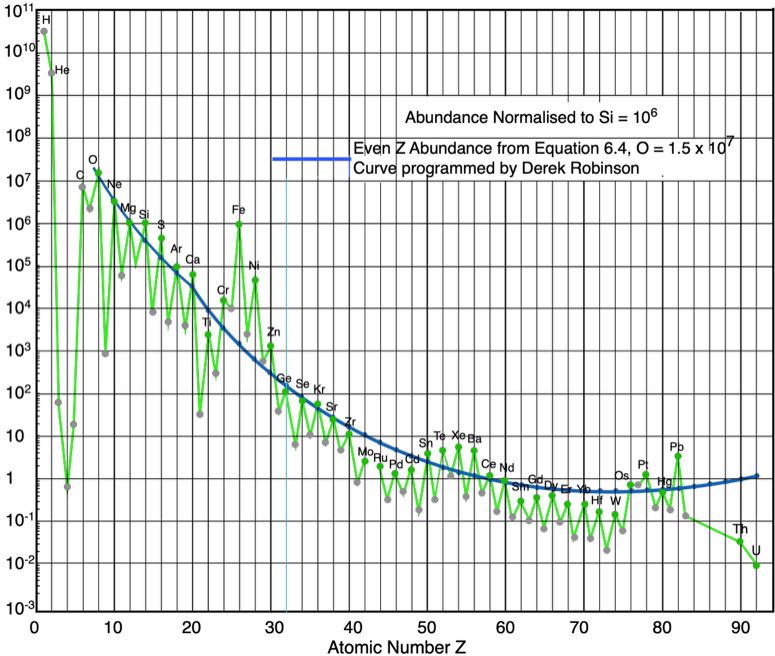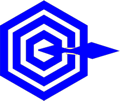


Figure 1 Proton paths (PP) to fusion.
Figure 2 The abundances of nuclei in the sun, measured and calculated.
Introduction
Background Science
Controlled Quantum Nuclear Fusion
STELLAR FUSION REACTIONS


[(AZ)⅓ + 0.62]2
NZ+2 = NZ
5.5(AZ+2 – AZ)
Fusion Foundations

Australia, Rest of World
America and Europe

Further details of the fusion mechanism can be found in Chapter 6 of
The Common Sense Universe
Is nuclear fusion a pipe dream that will always be 30 to 50 years away? We believe it is not and we have the science to back that up.
What follows is a systematic introduction to a new approach to nuclear fusion. This presentation proposes a mechanism that adheres closely to stellar fusion principles. It forwards a fusion mechanism could yield better results in significantly smaller and cheaper reactors and in a shorter time frame than the current state of the art. It uses a newly developed theory of nucleon structures that answers dozens of puzzles currently encountered in nuclear physics. It is an eye-opener into how hydrogen can be fused in reactors that mimic fusion in the sun.
Along the way it shows how far current fusion researchers have drifted away from how fusion works in the sun.
Nuclear fusion's promise of unlimited power, free of CO2 emissions, has enthralled scientists, politicians, and the public for decades. Despite the large time and money spent on fusion research, its promise is still believed to be decades from fulfilment. Fusion researchers portray it as imitating the way the sun generates its power, but is it?
Figure 1 shows the fusion reactions that occur in the sun.
Proton path PPI, shows that 61% of the sun's fusion energy is generated by helium-3 fusion. The remaining 39% is generated by fusing protons with lithium-7.
Both the PPI and PPII reactions involve 4 protons in the one fusion event. Current fusion models suggest high energies are required to force two protons together in a single fusion event. That is a big mistake that introduces unnecessary complexity.
Those reactions occur in the sun's central core, where the temperature is about 15 million degrees C. That equates to "all particles have an energy of about 1,500 electron volts (1.5 keV)". Fusion in the sun happens when two nuclei in close proximity, move towards each other with a combined maximum energy of about 3 keV.
Several different methods are being trialed to achieve fusion in reactors on Earth. In the Tokamak approach, particles to be fused are sent round in large circular toroids a few metres in radius with a much larger perimeter at energies of 100 keV, a temperature of ≈ 100 M˚C. That is an energy over 30 times that required for solar fusion.
Fusion researchers typically use the deuterium/tritium reaction, believing this to be their best candidate, see reaction {1
2D + 3T⟶ 4He + n + 17.5 MeV {1
Figure 1 shows reaction {1 is not on the pathways of fusion power occurring in the sun. It also has other problems. Tritium does not exist naturally. It is difficult to produce. The neutrons released in the reaction make the chamber walls brittle and radioactive.
That is a third big mistake fusion researchers make in trying to reproduce solar fusion in reactors on Earth. It is not even a reaction that gives fusion power in the sun.
When attempts to reproduce solar fusion in reactors on Earth differ so much from reality, is it any wonder that progress toward controlled nuclear fusion is slow.
Despite those and other limitations, the deuterium/tritium reaction, {1, is still seen by fusion researchers as the most promising fusion pathway. Multiple methods are currently being developed in attempts to exploit that reaction.
Another method is inertial confinement. 2D and 3T molecules are compressed to to a density about 150 gm/cm2, the sun's core density. The hope is the high speed and density will bring the nuclei together with sufficient energy and proximity to fuse.
Some reactors have shown that it does work. The random positions of the nuclei means some will fuse before others. Unless constrained the, heat from these early fusion events will scatter the remaining nuclei before they can fuse, thus undermining its effectiveness.
Other methods include firing high energy nuclei at each other through magnetic pinch confinement. It is difficult to achieve the high particle densities required for large fusion output. If fusion does not occur for all particles, the energy input is not recovered. Even if those problems are overcome, repeating the confined process in one location within a reactor puts huge demands on the materials in that location.
Controlled nuclear fusion is touted as humanity's future power source. Huge research efforts and resources are applied to overcome these problems. None of them use the fusion mechanisms that occur in the sun. None have achieved any significant success.
The following is a brief summary or how and why fusion occurs in the sun. It is followed by a description of a technology that is designed to use the sun's fusion mechanism. It is based on advanced nuclear physics research. It offers a method for attaining fusion in smaller and more versatile reactors than the current technologies in development.
It is suggested a better approach is to replicate the sun's fusion conditions. As mentioned above, these include:
1) Nuclei confined by the sun's high pressure/density produced by its gravity.
2) Nuclei at a temperature of 15 M˚C having thermal motion equivalent to an energy 1.5 keV.
3) That gives the nuclei a maximum fusion energy of 3 keV as the two nuclei move towards each other and fuse.
With that as the background, it is time to see what the sun fuses under those conditions. Figure 2 shows the measured abundances of elements in the suns surface. The green line joins the observed abundances of the elements plotted against their atomic number.
The blue calculated curve shows the predicted abundances of even Z nuclei when fusion occurs in the sun. Below oxygen (Z = 8), most of the even Z nuclei are within a factor of 3 of their observed abundances, with data that is spread over 7 orders of magnitude. Those elements that deviate from the trend have valid reasons.
The agreement between observed, green, and predicted, blue, shows there really is no repulsion between protons and nuclei such as Hg, which has 80 protons. Fusion experts believe there should be because their models use electric charge distributed uniformly throughout them.
Iron (Z = 26) has a particularly high value because it is the element with the highest binding energy per nucleon as well as the last exothermic fusion reaction. Lead (Z = 82) is high because it is the end product of most radioactive decay of nuclei of higher Z. Thorium (Z = 90) and uranium (Z = 92) have low values because they are radioactive. Many nuclei decay during the long time that it takes for heavy isotopes fused in the sun's core, to reach its surface.
The blue curve was calculated from the equation:
using oxygen's abundance, N8 = 1.5 x 107
This study of fusion showed how the process occurs. It is not a matter of "get enough particles at high energy and hope for the best". The mechanism of nuclear binding is very different from what is described in the accepted scientific literature. Without understanding the structure of the nucleons and how they bind to form nuclei, fusion studies are guesswork.
For example, figure 1 shows the fusion reactions in the sun that generate its heat. Current studies use tritium. It is not one of the solar fusion reactions, it has to be produced before it can be used. It releases a neutron that makes any fusion chamber material brittle and radioactive. It requires fusion energies of 100 keV and huge massively expensive equipment.
In contrast, figure 2 shows the results of this fusion mechanism. Those reactions occur at energies of ≈ 3 keV on nuclei constrained by the pressure/density due to the gravity of the sun's mass. It works! Nuclei energy of 3 keV is easy to achieve. Not so gravitational confinement. There are other mechanisms by which nuclei can be constrained.
There is evidence that constrained deuteron fusion reactions occur at lower voltages than when unconstrained. In Lattice Confinement Fusion, deuterons held in a crystal lattice fuse at lower voltages than in other situations.
That was attributed to the Oppenheimer/Phillips effect. They hypothesized that, when deuterons were constrained, the charge distribution shifted away from the charge of the other nucleus. Thus, fusion could occur at a lower voltage.
This method, like solar fusion, relies on the quantum properties of individual nucleons and nuclei. This quantum fusion process also offer the high probability of neutron free fusion reactions. It relies on the equipment design, not gravity, to constrain the nuclei.
It could be argued that the supply of helium-3 is so small and limited that it is not a viable fusion fuel. Figure 1 shows that proton-deuteron fusion producing helium-3 occurs in the sun. Any fusion methodology that reproduces the sun's fusion would also fuse helium-3. Fusing protons and deuterons to generate helium-3 releases 5.5 MeV, sufficient to also supply some electricity to the grid. Fusing helium-3 to helium 4 releases over 13 MeV per fusion event.
Lithium-7 fusion was usually ruled out because incident protons tend to knock nucleons out of the Li nuclei. That occurs at high proton energies. This proposed methodology uses low energy protons. Figure 1 strongly suggests they will fuse under solar fusion conditions, rather than knock nucleons out. Each proton to lithium-7 fusion event releases 17 MeV, without neutrons.
They are the PPI and PPII reactions in figure 1. An important feature is they both involve 4 protons in their fusion. That is strong evidence that like charge proton repulsion is not a significant issue in solar fusion. That is verified in figure 2.
It is possible the reactors could be fine tuned to enable two deuterons to fuse directly with each other to form helium-4 and release 24 MeV. That reaction does not occur in the sun because the deuterons quickly fuse with the protons to form helium 3.
In all situations, the fuels used are in great abundance. Their fusion provides high energy yields without releasing neutrons. That overcomes a huge hurdle associated with all conventional fusion reactors.
Other features include that the design is flexible and scaleable. Reactors capable of generating up to 5 MW should be able to housed in a shipping container. The reactors would operate at below their maximum rated capability. Their response time depends upon the thermal inertia of the reactors. Changes to their fuel input is as fast as adjusting a dial.
It goes without saying that these fusion reactors have no radioactivity associated with them. Should they overheat, be sabotaged or experience other problems, they will just stop working.
All of the principles for this proposed fusion mechanism have been independently tested. They have not been jointly tested in the proposed reactors. As with all development projects, no guarantee can be given as to their success. If the proposed reactors do not generate sufficient fusion, the other techniques currently under consideration will not succeed.
All things considered, reproducing the sun's fusion mechanism offers many possible advantages over the current methodologies. These include:
a) Using abundant nuclei like hydrogen, deuterium and lithium
b) Low energies, possibly < 5 keV
c) Fusion without generating neutrons
d) Smaller and cheaper fusion reactors
e) Confined fusion offers the high probability that all nuclei used in the reactors will be fused and generate heat at a much faster rate than the power consumed to induce their fusion.
All the above is based on a theory founded on the way that fusion works in the sun. It only works that way because of the structure of the nucleons and nucle.
In this study, the mechanisms associated with the strong nuclear force and the ways in which nucleons form nuclei, are well known. Understanding how fusion occurs makes it much easier to design the equipment and methodology to make controlled nuclear fusion happen.
A prototype has not yet been constructed. The mechanism suggests that the proposed fusion reactors will be smaller, cheaper and quicker to build than the reactors associated current fusion develpment projects. Existing reactor projects use tritons, 3T, which do not occur naturally. Their emitted neutrons make the material in their housing radioactive and brittle.
Current fusion practitioners do not know the nature of the strong nuclear force. Without that, the uncertainty of how fusion occurs makes their task difficult.
No estimates can be given for the funds required or the time needed to get working fusion powered reactors working. The best that can be said is that the smaller equipment and advanced in principle designs mean both should be significantly less than those currently stated for the major projects.
The advantages of the successful implementation of this technology cannot be overstated. This methodology has the advantage of being based firmly in nuclear physics that we understand well and reproducing the fusion reactions that occur in the sun. Proving the concept will only occur by building and testing a quantum fusion reactor. The initial model would be a low MeV reactor. It could be scaled up when its operating parameters are established. The versatility of this technology suggests a 1 MeV reactor could be housed in a shipping container. Water for steam to provide power is additional.
Opportunities
This is a new approach to fusion. Its theory is based on advanced nuclear research that explains how fusion occurs in the sun at energies much lower than those proposed in other approaches. Proof of this model will require building and testing a reactor. We consider the advanced scientific foundations give this technology a much higher possibility of achieving successful fusion than other projects.
A successful outcome will provide the technology needed for humanity's long term power needs. The process is scaleable. Indications are that the equipment for this technology will be smaller and cheaper to build and operate than other technologies for the same power output.
ETP Semra funded this research. Quicycle has aided and will continue to assist in this project. For corporations or countries wishing to be renewable energy super powers, this represents what is possibly the best opportunity currently available!
For more information contact
Implementation

